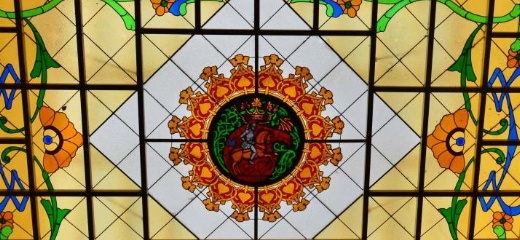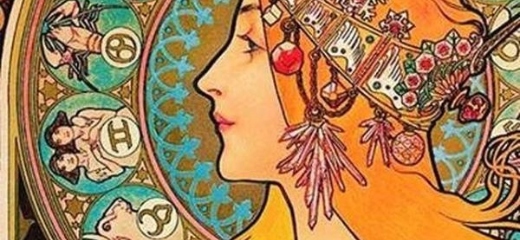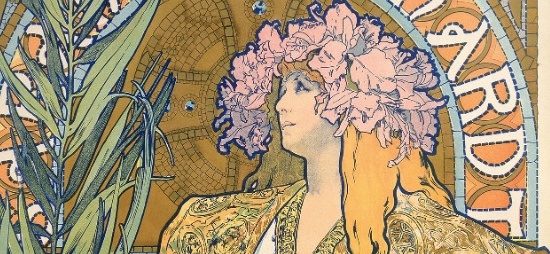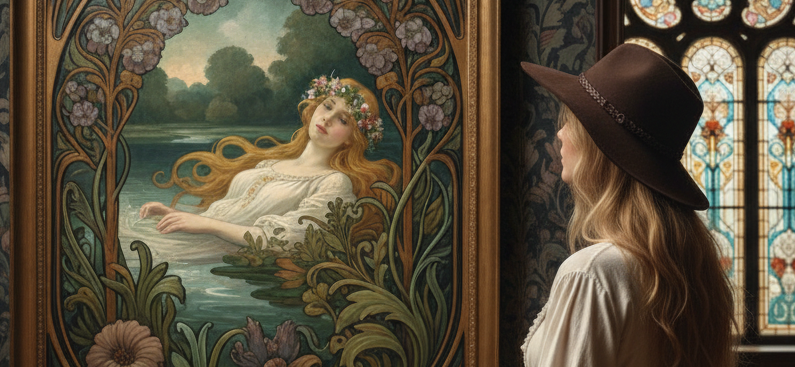Defined by sinuous curves, organic forms, and patterns alive with the flourish of flowers, vines, and fantastical creatures, Art Nouveau took deep root in the 1890s, peaked around the turn of the century in 1900, and continued to shape design well into the 1910s. More than a century later, this graceful, nature-infused style is experiencing a magnificent resurgence, inspiring everything from glamorous boutique hotels to the latest furniture collections. After years of straight lines and pared-back minimalism dominating interiors, designers are swinging towards something softer, richer, and more expressive—a lavish, nature-honoring aesthetic known today as the ‘New Nouveau.’
The original Art Nouveau movement—also known across Europe by names like Modernismo in Spain, Jugendstil in Germany, and Sezessionstil in Austria—was born out of a determination to do something radically new. Unlike the stiff, imitative historicism that permeated much of 19th-century art and design, Art Nouveau sought inspiration from the present rather than the past, specifically looking to the shapes and motifs found in the natural world. It was a determined, deliberate attempt to break away from the industrial mass production that followed the Industrial Revolution, emphasizing traditional craftsmanship and the creation of beautiful, decorative objects. This focus on the “total work of art,” or Gesamtkunstwerk, meant that the style permeated architecture, jewelry, glass, posters, and illustration, creating an essentially ornamental language that perfectly merged the utilitarian with the beautiful.
You may recognize Art Nouveau from the iconic, flowing portraits of women by Czech artist Alphonse Mucha, who captured the elegance and ideal beauty of the era, or from the intricate, vine-like ironwork of Hector Guimard’s famous Paris Métro entrances. The style’s defining characteristic is its undulating asymmetrical line, often mimicking flower stalks, vine tendrils, and insect wings—a ‘whiplash’ curve that became a metaphor for the freedom sought by artists breaking from tradition. Master architects like Victor Horta in Belgium and Antonio Gaudí in Spain pushed this language to its limits, creating buildings that felt like living, organic constructions, such as Gaudí’s famous Casa Milá in Barcelona.
Why the 125-Year-Old Style is Trending Now
The ‘New Nouveau’ revival is a reaction to several current trends in interior design. According to experts, after years of disciplined minimalism and straight lines, we are collectively gravitating towards bolder, more opulent forms. The style speaks directly to the ongoing movement toward more naturalistic, eco-conscious interiors, known as biophilic design. The rise of this design philosophy has deepened our collective desire to bring the essence of nature indoors, an impulse that aligns perfectly with Art Nouveau’s plant-inspired patterns and fluid lines. Furthermore, the modern iteration takes cues from the popular ‘loud luxury’ trend and the Art Deco revival, injecting the softness of Art Nouveau with a decadent, 21st-century glamour. As designer Kunal Trehan notes, “The New Nouveau is all about romance with a modern edge. It takes the fluid, nature-inspired elegance of Art Nouveau and infuses it with a touch of glamour.”
The difference between the original 1900s Art Nouveau and today’s New Nouveau lies in the layer of modern opulence. While the predecessor favored the wood tones and muted palettes of the Arts and Crafts movement that preceded it, the modern interpretation incorporates metallic accents and rich jewel-tones, reminiscent of Art Deco, its aesthetic successor. Gone is the muted restraint; in its place is a contemporary indulgence.
10 Ways to Add Art Nouveau Style to Your Home
Ready to channel the elegant spirit of Mucha and the grace of the Belle Époque? Here are ten expert-approved ways to inject the sophisticated New Nouveau look into your space:
- Introduce Sinuous, Asymmetrical Shapes: The foundation of the look is the curve. Compared to the hard, angular lines of minimalist design, Art Nouveau welcomed softer, asymmetrical lines. Start by embracing these iconic sinuous curves in your decor. Think arched mirrors, undulating furniture silhouettes, and flowing lines in everything from curtain poles to coffee tables.
- Incorporate Bold, Nature-Inspired Motifs: Art Nouveau emerged as a direct response to the Industrial Revolution, seeking to reconnect with nature. Nature-inspired motifs are absolutely key to recreating the look. Choose oversized florals, vine, or leafy patterns for a feature wallpaper or for soft furnishings like throws and cushions.
- Opt for Decorative, Refined Furniture: The original style emphasized craftsmanship over mass production. While the New Nouveau look is certainly decorative, it’s not meant to be fussy. Look for thoughtful pieces with an elegant, carved form. The magic lies in layering these organic forms with refined, metallic accents that feel indulgent yet contemporary.
- Layer on Rich Jewel Tones: While the original Art Nouveau used a cooler, more naturalistic palette, the New Nouveau look leans into the influence of Art Deco. Opt for colours like deep emerald, sapphire, ruby, and citrine to instantly create a sense of opulence, especially when layered together across upholstery, cushions, and curtains.
- Bring Glamour with Metallic Accents: The main difference between the classic style and its contemporary cousin is that added layer of shimmer. Don’t be afraid to introduce metallics. Using gold and bronze accents in furniture trims, tie-backs, lamp bases, or picture frames will all help to add that crucial touch of glamour and shine to your organic forms.
- Use Organic Ironwork and Glass: Seek out lighting fixtures or dividing screens with the classic ‘whiplash’ curve in wrought iron. Similarly, invest in pieces inspired by the glass designs of masters like Louis Comfort Tiffany or Émile Gallé, which feature fluid lines and veined, iridescent colors.
- Seek Out Figurative Designs: The Art Nouveau style often featured the idealized female figure—the femme nouvelle—in flowing gowns and natural settings. Look for figurative elements in lamps, decorative panels, or even modern prints, drawing inspiration from the mastery of Alphonse Mucha.
- Embrace Asymmetry and Rhythmic Flow: Art Nouveau rejected rigid symmetry. When decorating, let your eye follow the rhythm of the curve, placing objects and patterns in a way that suggests flow, lightness, and optimism, avoiding perfectly balanced, mirror-image compositions.
- Look to Japanese Influences (Japonisme): The original movement drew heavily on the linear patterns and two-dimensional compositions of Japanese woodblock prints (ukiyo-e). You can reference this today by incorporating decorative panels or screens with bold, highly stylized, flat linear motifs.
- Curate Sculptural Decorative Objects: The purest expression of the style was in the decorative arts. Look for small, beautiful objects such as vases, jewellery boxes, or lamps decorated with nature and animal figures like butterflies, dragonflies, and cicadas, ensuring they have that characteristic undulating, sinuous rhythm.
The Art Nouveau period was relatively brief, generally considered to have faded after 1910, partly because its emphasis on bespoke craftsmanship struggled to compete with mass production. However, its inspirational impact—which was famously revitalized in the 1960s with psychedelic graphics—has endured, bearing witness to the creative possibilities that are born when art, nature, and aesthetics converge in harmony. Today’s New Nouveau revival proves that great design, no matter how old, never truly goes out of style.
– The Sinuous Comeback: Art Nouveau is the 1900s Design Style That’s Suddenly Cool Again
– 10 Ways to Add New Nouveau Style to Your Home: The 1900s Design Trend That’s Blooming Again
– From Mucha to Modern: Why Art Nouveau is Back in Fashion and How to Get the Look
– The Sinuous Comeback: Art Nouveau is the 1900s Design Style That’s Suddenly Cool Again





